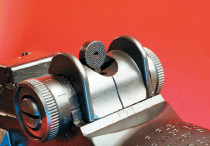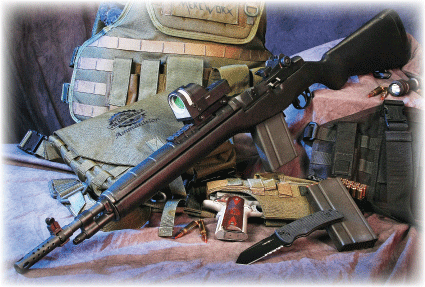Capitalizing upon the success and reputation of the M1A, Springfield Armory began producing its “Bush Rifle” in the mid-80s. The next evolution came in 1996 with the Scout Squad. The niche that these weapons were designed to fill was that of a rifle which was shorter and handier for officers in the field, and also as a bush rifle for hunters. Both rifles, of course, have their roots in the rugged military M14.
 The latest incarnation has a forward-mounted sight base which makes the attachment of a sight easy and convenient (the original M1A had no such sight mount) and its forward mounting gives access to the receiver and its mechanism.
The latest incarnation has a forward-mounted sight base which makes the attachment of a sight easy and convenient (the original M1A had no such sight mount) and its forward mounting gives access to the receiver and its mechanism.
Another recent factor that makes the M1A platform still more viable as a rifle for law enforcement is the advent of modern ammunition, which makes the over-penetration problems associated with traditional .308 ammo a non-issue. The designs of ammunition such as Hornady’s TAP (Tactical Application Police) or Federal’s Tactical TRU (Tactical Rifle Urban) control penetration to a depth appropriate for police use.
Advertisement — Continue Reading Below
Gun Details
The only significant modifications necessary for the Scout’s reduction in length was a larger gas port in the barrel and taller front sight. The receiver is CNC machined from 8620 steel. The bolt is from steel forgings. An 18-inch chrome-moly barrel is turned from a blank and has a 6-groove 1-in-11-inch right-hand twist.
Sights are the same as those found on the M14: an ear-protected front blade and the large-knobbed, windage and elevation incrementally adjustable rear peep sight, also flanked with protective ears.
Mag release is a steel lever situated just aft of the mag well, its rear-facing surface has a convex curve. The bolt stop/release is on the left-top side of the receiver.
Advertisement — Continue Reading Below
All other parts are a mixture of genuine GI parts with a few outsourced; each are high-quality machined units. Interestingly, a couple of the original M14 machine tools, are incorporated in production.
Again, the Scout integrates a forward-mounted optical sight base, an update to the M14 platform, which modernizes the weapon system in an age where most police will mount either a reflex scope or telescopic sight. The sight base is machined from aircraft aluminum and is hard coat anodized. It sits immediately to the rear of the operating rod guide boss. The portion of the barrel that the mount clamps around is tapered from the breech forward and the mount is machined to match this taper. There are six cap socket screws that secure the two halves together, and also two set screws through the top half of the mount that bear against the barrel as added protection against rotational force.
A proprietary muzzle stabilizer was developed based upon Springfield’s experience in action-style shooting in the late 80s and early 90s. The stabilizer functions as a compensator and is ATF approved as a muzzle brake.
Advertisement — Continue Reading Below
The Scout Squad is available in a traditional American Walnut stock, Mossy Oak Camo, or the more modern black fiberglass, as with our test gun. Both the black fiberglass unit and the Mossy Oak Camo version are GI fiber stocks that have been updated with a filled-in selector cut out and a new finish. A sling swivel is mounted under the forend of the stock, and another is fixed at the rear of the buttstock. Barrel, receiver and all steel parts are parkerized. Fit and finish are excellent throughout. Our gun shipped with one 10-round magazine.
Range Time
Being a fan of the M14 and all of its civilian M1A variants, to include offerings such as the Scout, I was anxious to get some trigger time in with this gun. We set up 8-inch Visicolor targets from Champion Traps & Targets at 100 yards to conduct our accuracy testing. The gun was rested on a sandbag atop a bench, and we used the 10-round magazine to avoid any chances of it contacting the bench and creating problems. We were blessed with a fine day for shooting, the temperature was a mild 65 degrees Fahrenheit, the air mostly still with 5 mph breezes and the humidity at 23%.
The first thing one notices about the weapon is its weight. If you’re used to the AR15 platform, you’ll find it about a couple of pounds heavier at 9 pounds unloaded. That’s just a bit less than the standard M1A. The textured fiberglass stock gives a good surface for gripping the gun, and the more traditional stock, sans pistol grip, shoulders and points plenty natural, much like your shotgun or hunting rifle. Its matte black stock and parkerized metal receiver and parts are perfect for the law enforcement role, making the entire weapon non-reflective.
Advertisement — Continue Reading Below
The action was very slick. Working the mechanism with the weapon unloaded was smooth, and letting the operating guide fly forward with a loaded magazine sent the bolt and round slamming into battery with buttery precision. Just to be sure, though, I lubed the action with Gun Butter lubricant before our tests.
The Scout’s trigger was very nice. It broke very crisply at 4.5 pounds with about 0.13-of-an-inch play before any resistance was felt, then another 0.13 of an inch of resistance before the break. The smooth, crisp trigger made staying on target easier.
For those of you not familiar with the M14/M1A family of rifles, the safety selector is a flat piece of steel, which protrudes vertically through a slot at the front of the triggerguard. To disengage the safety, one extends the trigger finger forward from the trigger to push and snap the safety toward the muzzle. This is a simple enough arrangement, though I don’t like the idea of doing it with a gloved hand. Under most any other circumstances, it’s acceptable.
Advertisement — Continue Reading Below
The iron sights are excellent for anything but low-light shooting. The large knobs on either side of the rear aperture adjust the elevation by clicks on the left side, and the windage in the same way on the right. Nothing could be simpler.
Since the Scout Squad employs an integral sight base, we elected to mount a Meprolight Mepro 21 reflex scope on the gun. The Mepro 21 is a red-dot reflex sight designed for quick and instinctive target acquisition. The design allows both-eyes-open-shooting, best for tactical situations. This works well in conjunction with the Scout’s forward mounted sight base, allowing the shooter to take maximum advantage of maintaining a peripheral field of vision.
The Mepro 21 is rugged and reliable, it has no circuitry or batteries to fail, and can even withstand being submerged. An internal tritium source emits power for low-light scenarios, and fiber-optic collectors gather light in lit and daytime situations, automatically adjusting to the light levels. The brighter the light, the brighter the dot. The sight is suitable for use with Night Vision Goggles or scopes, including those with GEN III tubes, and adapters are available for all the common mounts (Weaver or Picatinny rails, M16 carry handle, NATO, etc). The unity (1x) power lens diameter has unlimited eye relief, 10 to 600mm aiming dot, and a 5.5-MOA (4 optional) resolution. The unit weighs 7.02 ounces. The particular scope we used had a quick-detachable throw-lever mount that instantly locked onto the Scout’s Picatinny configured sight mount.
Advertisement — Continue Reading Below
We took several rounds to zero the Mepro 21 on the gun. This is achieved by simply turning the flat-head screws on the top and side of the sight body. Once the gun was zeroed, we began firing three-round groups for accuracy.
RELATED: The Self-Illuminated Meprolight Mepro M21 Gets a New Reticle
The best group of the day came from Hornady’s 168-grain TAP. The first three rounds went just an inch even. Winchester’s Ballistic Silver Tip funneled into just 1.44 inches, CorBon 130-grain DPX into 1.5 inches and Black hills 168-grain BTHP into 1.63 inches. This was good for a reflex sight with just 1x magnification.
Advertisement — Continue Reading Below
The recoil was much lighter than one might expect from a rifle chambering the .308, the muzzle stabilizer is evidently well designed, performing its intended purpose nicely in tandem with the grooved hard-rubber buttstock. Standing shots were quite comfortable, one could easily shoot this weapon for several hundred rounds in a session without becoming sore.
The controls were ergonomic and user-friendly. To those accustomed to the AR15 platform, they may seem foreign at first, but to me, a big fan of the FAL, they were quite natural. Grasping the magazine with the hand, for instance, puts the thumb in a natural position to depress the ambidextrous magazine release and rock the magazine heel out. Magazines were inserted toe-first and then the heel rocked up into the mag well, where they positively clicked into place, similar to FAL and AK47 rifles. The bolt release was easy enough to manipulate, though I found grasping the operating rod and releasing it to be more natural.
I shoulder-fired several shots from both 25 and 50 yards, easily scoring hits, all within the 8-inch Visicolor targets’ large scoring ring. The Scout Squad functioned flawlessly throughout our tests, never failing to go bang.
Parting Shots
Why a Scout? A rifle such as this is an excellent alternative to the dominant AR15. Superior ballistics of the .308 round make it much harder-hitting, and the more reliable gas-piston design renders it much easier to maintain and clean. These factors combine for an outstanding rifle for law enforcement. Fortunately, that extra power doesn’t come at a price of punishing recoil, nor a weapon that’s difficult to shoot effectively.
Advertisement — Continue Reading Below
If you’re considering a rifle for the job, don’t overlook the Scout Squad as an excellent choice. Enhanced power, rugged reliability, 1 MOA accuracy, and simpler, easier maintenance are reason enough.























